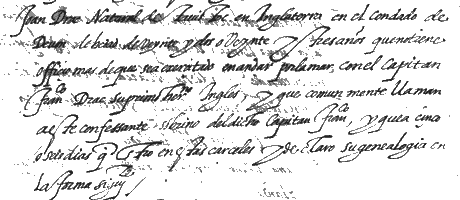The deposition of John Drake to the Inquisition in Lima in 1587 is among the documents that have been digitalized by the Spanish Ministry of Culture, and made available through their PARES website (ref. AGI,PATRONATO,266,R.54).

and Francis Drake [Francisco Drac]
John Drake was a first cousin to Francis Drake, the famous English corsair. With his ship, the Golden Hind, Francis harrassed Spanish shipping and settlements, especially along the length of the American Pacific coast, eventually accomplishing the second recorded circumnavigation the globe (1577-1580).
The events described in this narrative occurred during the first phase of European discovery, exploitation and conquest of the New World. Spain and Portugal had the early advantage, which they defended against newcomers, such as England. The result was English aggression: corsairs were empowered to take by force the riches being obtained by the other powers, especially Spain. Between 1577 and 1580, Francis Drake surprised various Spanish colonies, attacking ships, cities and individuals, demanding ransoms, destroying newly-established communities and causing general panic. At an early stage in the voyage, Drake captured and impressed the Portuguese pilot Nunho da Silva, whose experience proved valuable in their journey down the Brazilian coast, and subsequent traverse of the Magellan Strait. Since John Drake was a member of Francis’s crew, his account was still of great interest to the Spanish Crown a decade later.
By 1582, John was back on the seas as member of a small fleet which had been organized to trade with China. Arriving at Brazil, the ships decided to separate and John headed for the River Plate, in search of supplies. Unfortunately, his ship was wrecked and he was held captive by the Charrúa Indians for over a year. Eventually, he and two companions escaped in a canoe, crossing the river and reaching Buenos Aires. Subsequently, they were transported to Paraguay by Don Alonso de Vera y Aragón, finally being sent to Lima to appear before the Inquisitor, Don Antonio Gutiérrez de Ulloa, in 1587.
This interview, recorded by the clerk Jerónimo de Eugui, provides us with a first-hand account of Francis Drake's voyage round the world. In his declaration (January 1587), John says that he is 22 or 23 years old; and that he was 14 or 15 years old at the start of his journey with Francis (December 1577). Comparing his statements with those made by other members of the expedition (Cliffe, da Silva, Fletcher), we conclude that his information is reliable. His status as Francis's attendant perhaps allowed him privileged access to meetings and decision-making. All this information would have been assimilated and consolidated in the course of the voyage: as da Silva reports, John and Francis spent a lot of time together in their cabin, and both made drawings of scenes from the journey.
In his narrative, John Drake gives specific information about the trip — significant events, and the route followed. He recalls vividly certain details of the journey, adding human interest to what would otherwise be a dry travelogue. His remarks on contacts with the native inhabitants of the New World are particularly interesting, referring to clothing and possessions, physical appearance, behaviour and morality. For example, at Bahía de Lobos he observed the Indians' unwillingness to accept gifts face-to-face; and saw garments apparently made of feathers. He also reports an incident of self-mutilation with an arrow-head, interpreted as an expression of remorse. They met a small group of canoe Indians in the Magellan Strait, with whom they bartered for food; and also found evidence of canoe Indians on the southernmost part of the Pacific coast.
Other details, such as Francis Drake's use of native plants to improve the crew's health, indicate a growing awareness of the importance of diet on long sea voyages. From a linguistic perspective, one sees how terminology from past experience was applied in naming new phenomena: for example, featherless ducks to identify the (as yet unnamed) penguins. The use of the term giants repeated the existing belief in the great height of the Patagonian Indians, perhaps more an appreciation of relative rather than absolute size.
The document examined consists of 13 sheets. The first pages deal with administrative details of the hearing, genealogy and religion. Our extract begins at page 2v (declaration concerning the voyage of Francis Drake) and ends with his arrival at the island of Mocha, Chile, on page 5. The later pages cover the remainder of Drake’s voyage, and John’s misfortunes on his own expedition (1582).
Note: John Drake’s deposition was apparently referenced in Zelia Nuttall’s New Light on Drake / A Collection of Documents relating to his Voyage of Circumnavigation, / 1577-1580, Hakluyt Society, 1914. However, we do not know whether that edition included the full deposition, or parts of it, in Spanish, or in English translation. Since we have been unable to locate on Internet any transcript of these pages relating to Patagonia, they are offered here for the convenience of the widest possible audience.